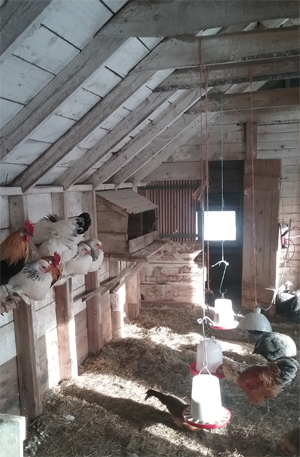

Buff Laced Polish, Light Brahma, Easter Egg, Blue Silkie Bantam, Golden Duckwing Phoenix Bantam, and Royal Purple Guinea Chicks/Keets at Eight Days Old, Purchased from Cackle Hatchery
Eggs are a great food and there is no better egg than the one you just collected from your own backyard coop. Chickens start laying in 5-12 months and continue good production for about 2 years. You will want to get a breed intended for egg production.
Chicken is one of the most consumed meat products. Unfortunately, to get one of your backyard birds to turn into what you can buy in the store, you need to kill it, pluck its feathers and clean out its insides. Birds can be butchered between 8 weeks and 8 months old, after which the meat is considered too tough. You will want to get a breed intended for meat production.
Let's face it. Chickens poop and that poop will get stuck to the bottom of your shoes. If you let them wander around your yard, that poop will be fallen wherever they wander. Cleaning out the coop and cleaning food and water containers will be part of the experience.
Many people turn their chickens into pets. To do this, you need to sit with them as chicks. Still, they are fairly docile and hens can become accustomed to being picked up and held. Roosters on the other hand can be problematic and it's important to watch them around children.
In comparison to most animals, chickens are easy and take 15 to 30 minutes out of each day. Sometimes you just need to collect eggs. Sometimes you need to refresh their food or water. Sometimes you need to clean out their house and put down new bedding.
Chicken predators include racoons, foxes, bobcats, fishers, coyotes, dogs, owls, and hawks. For this reason they need secure nighttime housing. They may need secure daytime housing.
Many chicken breeds are quite beautiful to look at. They make interesting clucking noises. They scratch in the dirt to look for food. They scratch up loose soil and douse themselves for a dirt bath. Different breeds can lay different colored and sized eggs. Some waddle. Some fly a little bit. Some get into fights.
Updated: 5/1/19 KAO

It is safest and easiest to feed chickens a commercial product that is already a balanced diet. Look up "animal feed store" or "livestock feed store" on google to find a supplier near you. Chicks need a chick starter mix, then a grower mix, or a starter/grower mix, then a layer mix once they start laying eggs. They should have food and clean water available at all times. If your birds are not allowed to roam outdoors where they can pick up stones to help grind their food, also offer them grit. And that's it for what's required.
In addition, some people recommend making oyster shell available free choice for added calcium. If you like, you can supplement their regular feed with treats. They will eat grains, fruits, vegetables, grasses and insects. You will find treats like scratch grains and mealworms in the same store where you buy your regular feed. Most table scraps are OK, but not avocado. It is possible for them to overeat and become fat or sick from certain treats like corn or mealworms, so keep this in mind.
Hanging feeders and waterers minimize waste. They prevent the birds from scratching food out of the feeders or scratching debris into the waterers. You can also place the feeders on platforms.
Updated: 6/4/19 KAO
This is a Brahma/Easter Egg cross rooster on his safe perch in the room where he grew up. His momma has long since moved on to roost with the rest of the chickens. This young rooster doesn't seem to stop at the feeders on his way inside at night because the other roosters bother him, so he gets first dibs at the newly refilled waterer. He'll get the feeder brought to him next. He's very spoiled, but he needs to get over it! He's almost bigger than most of the other roosters at this point. (Updated 7/6/19)

Chicken housing can be simple or not and cost anywhere from $200 to $4,000. You can build your own or buy one already made. Things to consider:
They need about 4 square feet per bird, but consider the size of your birds. Brahma hens are large and need the full 4 square feet, but bantams are small and may need only 2 square feet. A 4' x 4' coop will hold 4 birds. An 8' x 8' coop will hold 16 birds. Count only the actual building, not the outdoor run. Most premade coops are too small for the number of birds they say they can hold. Chickens roost at night to sleep. They need about a foot of roosting space per bird. Consider where the food and water goes. Also consider accessibility for yourself. Will you have to get inside it? Is it large enough for you to do that?
They absolutely need to be protected from predators. A 1/2" hardware cloth will need to be over windows. Why such small holes? A racoon can reach through fencing and kill a chicken. The closures on all windows and doors will need to be secure. The building part of premade coops may be predator proof, but the outdoor runs are not because a predator can dig under them and they are probably not fenced with 1/2" hardware cloth. A predator proof outdoor run for chickens means 1/2" hardware cloth all around, including the top, with a perimeter fence that is either buried straight down into the ground 2 feet or forms an apron spread out 2 feet around the base and anchored into the ground. Any fence touching the ground should be plastic coated as the galvanized just doesn't last. Also, don't bother with typical chicken fencing as predators can tear through it. In addition, if you are in bear country, you will need electric wires properly placed to deter them. It's a given that you need a predator-proof house in any area, but may not need or care about a secure outdoor run. Many flock owners are fine with free ranging their birds during the day and taking the risk of losing some to predators.
Given their druthers, chickens prefer to lay eggs in a nice comfortable nest, not on the floor or the ground. The standard is 1 box per 4 hens. The box needs to be large enough to accommodate your largest chicken. Larger boxes are fine as more than one hen will lay in the same nest, but smaller boxes are not. Suitable dimensions would be 12' wide x 14' deep x 12' high. They prefer a dark space, which is why boxes have sides and roofs and are positioned so the morning sun isn't shining into them. You also want a lip on the front to keep in the bedding and prevent eggs from being rolled out. And if your box is high up on the wall, it needs a landing spot in front. They also need to be convenient for you to access to collect the eggs.
Hanging feeders work best, so a way to hang them is great. Again, they need to be convenient for you to access. Keep in mind you will need a place to store extra feed. Mice and rats can eat into the feed bags you buy at the store, so you'll want to transfer the contents to metal garbage cans. And those need to be in a building inaccessible to raccoons and bears.
The building doesn't need to be insulated or even air tight. You don't want a warm airtight house as this can generate humidity and lead to sick chickens. But you don't want any drafts that the chickens can't avoid either, like a big gap between the boards in the outside wall of a nesting box or beside a prime roosting spot.
One of the issues I see with many small chicken houses is the lack of windows. When birds are hot, they will be visibly panting and roost holding their wings away from their bodies. You don't want these poor birds stuck in a box with no air flow. In the spring and fall, I open the windows during the day on warm days and close them at night. During the summer, I open all the windows in my coop and leave them open.
The floor is probably the most problematic. Wood floors are natural, healthy, and warm, but cracks in a floor over an open crawl space will allow food to fall through and attract rodents. Those rodents can then chew through the wood floor. This is the biggest problem with my wood building. I have an old stone foundation wall and really like the way it looks, but it has all sorts of holes in it. There are other options. Elevate the coop. Eliminate the floor altogether. Apron the perimeter with hardware cloth. Bury hardware cloth around the perimeter. Pour a concrete floor.
Most people seem to like wood shavings for bedding and seem to have no problems with it, but I worry about them eating bits of wood that look like their food. A lot of food ends up on the floor and they like to scratch in it. I prefer to use hay. They can scratch in it, look for seeds and insects, eat it, and it will never harm them. Plus it doesn't get scratched into the waterer or feeder the way shavings do. If you use shavings, do not use cedar or cypress as these are toxic to poultry.
Electricity is really convenient if you can manage it. It's nice to have lights. It's nice to be able to plug in a water heater or heat lamp. I use red light heat lamps to keep my waterers from freezing, but this also serves to provide my chickens with light at night during the winter and that keeps them laying eggs. It's also nice to help mama hen warm any chicks born during the cold season. Of course, when using heat lamps, it's very important to position them properly away from anything flammable and cage them well in the event they should fall into the bedding. Also, do not use teflon coated bulbs (shatter resistant) as the fumes from them can be toxic to poultry.
It's nice to let your chickens out. One popular style of coop allows you to drag the entire thing around, so every day the chickens get a new patch of grass. However, keep in mind that these coop/runs are not predator-proof. They are more about keeping the chickens confined than protecting them. Honestly, if you aren't worried about your chickens running off, you might as well let them free range.
Updated: 6/4/19 KAO